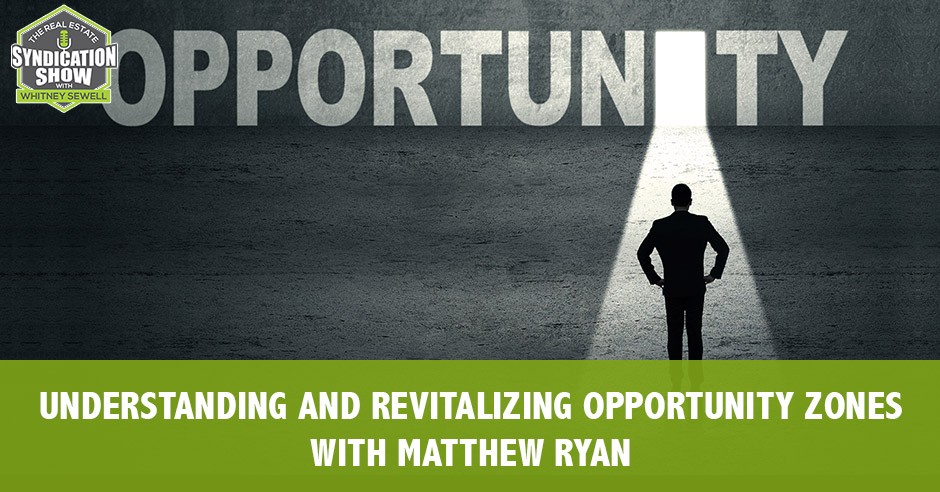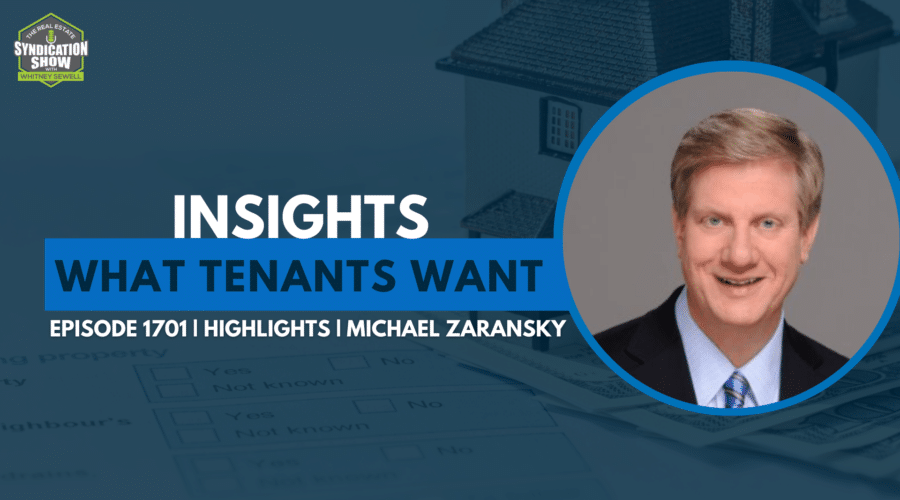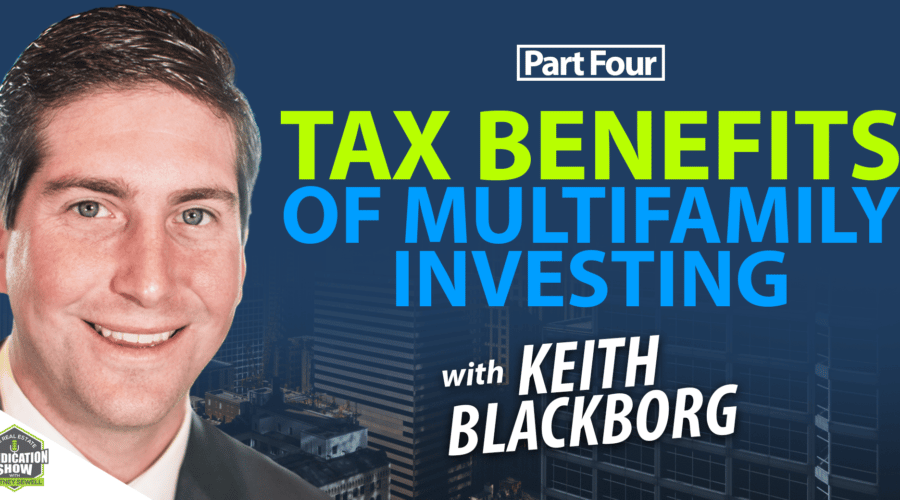Listen to the podcast here:
Taking something that has good bones is the axiom of most realtors. They take and revitalize these zones and turn them into opportunities. Founder of re-viv, Matthew Ryan defines what opportunity zones are and outlines their benefits. With close to ten years of experience in real estate and construction, Matthew shares the tools in finding an opportunity zone, and tackles the risks in investing in one versus value-added multi-family. As he goes through the ways to mitigate the risks in this kind of real estate investment, find out what co-living models are and how substantial improvement clause works.
Our Gracious Sponsor:
Are you tired of answering emails from investors about when they’ll receive their K-1s?
Let The Real Estate CPA handle the accounting and taxes on your next syndication and they’ll file your tax returns by March 15th so you can get K-1s to your investors by the individual filing deadline on April 15th.
Not only will this reduce headaches, but it will help you retain investors over the long-term by improving investor experience.
The Real Estate CPA is now offering a Special Virtual Workshop to the listeners of The Real Estate Syndication Show on How to Answer Tax Related Questions from Your Investors!
Learn more today by visiting: http://bit.ly/Real_Estate_CPA
—
Watch the episode here:
Understanding And Revitalizing Opportunity Zones with Matthew Ryan
Our guest is Matthew Ryan. Thanks for being here, Matthew.
It’s my pleasure.
Matt’s experience spans ten years as an entrepreneur. He launched his first company out of the recession in 2009 to capitalize on the growing opportunities in energy efficient and green building within the construction sector. Pivoting to real estate after making his first investment project in 2013, Matt has compiled a 30% IRR on all investment projects while building a personal portfolio worth over $2 million. He’s handling all facets of the transaction: the broker, property management, general contractor, all while positioning re-viv to become the market leader in community revitalization efforts. Matt, thanks for being on the show and providing your experience and expertise. I’m looking forward to this. Give the readers a little bit more about your background and what your focus is.
Reiterating construction, energy efficiency and green building was an exciting part of my career. Being trained in this field of building science, which was very much about comfort, air quality, energy efficiency and durability of structures. It was a great experience. What I enjoyed in contracting, I saw an opportunity to take that knowledge and expertise and parlay it into real estate investing. Re-viv is focused on an opportunity zone fund that we’ve formulated. We’re looking to capitalize on the minimum co-living projects in the multi-family sector. We are focused in the East Bay market in Oakland as well as parts of San Jose. We’re rounding out our capital raise and getting ready to place the capital that we raised in the first quarter and looking to raise some more in the second quarter.
Let’s go into that a little bit. You said that you’re focused on the opportunities on fund, is that right?
Opportunity zones, qualified opportunity zones, there are a lot of different names for it, but it was under the Tax Cuts and JOBS Act. It was a provision in the Tax Code that’s created a pretty substantial tax referral strategy very similar to 1031 exchange.
Give us some benefits why we should be looking into opportunity zones and why that’s important and then we’ll go into some more details of the process that you’re going through.
Specifically, investors who have a large capital gain. It happens all the time in real estate. You’ve got large paper equity that you’re sitting on, a substantial profit that you’re sitting on. What do you do? You see the questions on BiggerPockets. Everyone’s who’s been in real estate hopefully gets to that point. 1031 exchange, have you completed one before?
No, I have not.
It’s tough. You have 45 days to identify three assets and you have to close on one of those three in 180 days. With opportunity zones, you’ve got a little bit more flexibility. You’ve got 180 days to place your money, that capital gain into a qualified opportunity fund. The qualified opportunity fund then has to go up and purchase the asset and make substantial improvements. There’s a substantial improvement clause in there within 30 months. The way that the substantial improvement clause works, you buy a property for $1 million and you assign $600,000 to the builder, $400,000 to the land. You need to improve that building by $600,000. Once you do that, you defer your original capital gain up until the year 2026. There’s what they call a step-down basis. It can get a little technical at this point. Let’s say you had $100,000 gain that you deferred into an investment. In 2026, you would pay only 85% of the original tax that you would be obligated to, had you not looked into a qualified opportunity fund.
We’re going to pay how much?
You pay 15% less of your original tax liability. Your $100,000 investment, let’s say you owe $28,000 on that. You’d only be taxed on $85,000 as opposed to $100,000. The other benefit is at the exit because if you keep the investment in the opportunity zone investment or fund for ten years, you pay zero capital gains on exit. It’s not like 1031 where you have to keep rolling over. You’re still trying to avoid that game with a 1031 and eventually, the government is going to get their money. The benefit is once you leave after the ten-year period, opportunities and investment, you pay zero capital gains on that new appreciation. It is a deferral as well as there’s zero tax on the gain of the new investment. It’s got a little bit more flexibility, a better tax benefit than 1031. It does come with risks. Your census tracks, they’ve been designated as distressed areas. If you google opportunity zones and you look at some of those in your state, some of these are in areas that are already prominent up and coming areas.
How do we find an opportunity zone or how do we know that that’s something we should be pursuing? Is it something everybody should be pursuing?
For one, the substantial improvement clause is going to take a lot of your value-add guys out. I know a lot of syndicators are focused on value-add. You’ve got to hit that substantial improvement. You’re looking at very heavy capital infusion projects or roundup development. Those are the two key things to understand.
[bctt tweet=”Take something that has good bones.” username=””]
When you say the value-add guys, if we’re looking to come in and put $5,000 gain to do a value-add, that’s not going to be near enough? Is that what you’re saying?
You’re going to have a tough time hitting that $600,000 on that million-dollar project. You’re going to spend a lot of money per door. It takes it out. The intent of the program was job creation. Development projects, typically they’re going to yield more jobs. That is the intent and that’s why they had the substantial improvement clause. The development piece plays are going to make the most sense. Heavy gut rehabs or maybe you’ve got a multi-family project that you’ve got a portion that you can develop. You’ve got some vacant land. Those also work well. It is a little restrictive as far as the type of investments you can make. As far as getting involved, just google opportunity zones in your state. Every state now has their own mapping tool. You can take an address and look to see if it’s an opportunity zone.
We can focus on that area and try to find distressed properties or vacant land, something in that area.
That’s very common. I know a lot of people use various tools, CoStar, ProspectNow. I know CoStar has an overlap tool for opportunity zones. They have map overlay. There have been at least two or three new software launches that I’ve seen in the marketplace. People are coming in with these tools. I’d still say find the free one. Go to Google, go to your state website, and more likely, you’ll be able to find something, for sure.
You’ve mentioned you have a strong construction background. I can see why that would be very useful looking for highly distressed properties, looking for opportunity zones and those types of highly distressed properties. Is that what you started with? Is that the type of properties you knew you were going to do right from the beginning?
It is. It’s what I enjoy the most. I like taking something that has good bones. Even throughout my hobbies, I found myself enjoying taking old stuff, reconstructing it and building it back together. It parlays into our investment thesis, which from a broader perspective is community revitalization projects, which these heavy value-add, these projects are already challenging enough. We had to take it a step further and find something equally challenging as community revitalization, which is a difficult process. You’ve got a disaggregation between the investors, the community members, the public entities that are trying to bring these communities up while also balancing old style community members who had been there for years. They experienced the blight, the lack of opportunity within their neighborhoods, and all of a sudden free market comes knocking on their door. It very much plays into our thesis and what we’re trying to do as far as providing the tools, the resources, the intellectual capital to make this process more efficient. We feel like the public sectors are failing to address it.
You mentioned about risks, about pursuing opportunity zones. I’d like for us to go through a few of those in a little more detail. Maybe some common ones that we wouldn’t normally think of that specific to opportunity zones.

It’s difficult to find something different because every investor needs to be very careful about where they’re investing. It’s the age-old thing like you don’t want to find yourself too on the fringe. You don’t want to invest in war zones. I think you have to look at and redo that internally. Where is this community set up for success or is this just a high cashflowing opportunity? You can’t get starry-eyed with the numbers and the cashflows. You’ve got to look at the community and we look for that too. We’re looking is there transit stops or are there plans for transit infrastructure? We look at the growth and income growth, growth in household income, an influx of a younger demographic or an older demographic too. Seniors are also flocking to urban cores. We’ve known that, these surban arteries, to steal a term from John Burns. You’ve got to do your market research on this and you have to be diligent. You’ve got to drive neighborhoods, all the age-old stuff that everyone talks about.
For us, we look at it very much at a statistical analysis first and then it’s very much a field. You’ve got to look at your local governments too. Are they engaged? Are they on board? Are they just posting this stuff up on their website and saying, “We hope we get some opportunity?” There have been local governments and even states that are beginning to build incentives on top of the opportunity zone tax referral strategy. I think when you see a level of engagement at that level, that’s when we start to become interested. The public players have to be on board too and they have to want to see the growth. If they’re on your side, they can be a part of your story, that’s going to help. I know here in California, oftentimes developers aren’t always looked at it in the most trustworthy lens. We looked at the enemy as the guys that are gentrifying these communities, taking people out of their communities and pushing people out. We get a bad rep.
I appreciate you mentioning too, looking at the infrastructure of the city, is there room to grow? Are they growing? Things like that before looking at the cashflow. It’s so important. As far as thinking about an opportunity zone, if I’m going to pursue an opportunity zone, what are some things that could possibly go wrong? Thinking about the substantial improvement clause, what are the chances that we’re going to build this addition or we’re going to turn this property around in just a major way, but then it can’t happen. What’s going to happen? We got up at $600,000 in it, but we only got to $500,000 for whatever happened, that’s all we can do.
That is an inherent risk because you are playing by the government’s rules and you have to be very careful. The first thing that you need to do to mitigate that risk is you need to have a qualified professional: an accountant, CPA, as well as a securities attorney who knows what they’re doing. I saw it on BiggerPockets. People are like, “I’ve got this great deal on opportunity zones. Now, what do I do?” Those are the people that are going to start to hurt a little bit because it’s a web of details. To be honest, we started tracking this piece of legislation a few years ago before it even got passed. I’ve interviewed multiple securities attorneys and conferences galore. I’m almost burnt out on this. I’m still learning new stuff every day.
There’s still always someone who brings a point to me and I’m like, “I didn’t even know that.” The compliance piece is going to have to be integral to your strategy. You have to know the ins and outs. I don’t want to scare anyone. For an individual person trying to make an investment, just one individual, it’s fairly simple. There’s an 8996 or 8896 form that you have to fill out through the IRS. Having a good qualified securities attorney or an attorney who knows this stuff, if you’re syndicating on these securities, and a CPA is going to help you with compliance. That’s the best way to mitigate some of your downside risks. You made a good point, substantial improvement clause, there are some hurdles to clear. I think you’ve got to be very diligent on understanding what my traps are, what my pitfalls are.
At the end of the day, if you make a good investment and it doesn’t work out, so you miss that substantial improvement, you’re going to pay taxes on it, and that sucks. If you made a good investment, it’s not a horrible thing. That was the message we saw in a lot of the conferences, everyone’s saying, “Opportunity zones are going to make deals look better. They’re going to help. They’re going to add a sweetener to an already good deal.” You’ve got to look at it through that mentality.
What would you say is different about your team since you’re pursuing opportunity zones as opposed to somebody that’s pursuing value-added multi-family?
[bctt tweet=”You’ve got to be very diligent on understanding what your traps and pitfalls are.” username=””]
I do think we’ve carved out a good niche. For us, we’re not doing it as a full open-ended fund. This isn’t a pooled fund. We’ll be focused on one specific asset. Each deal will be underwritten as an individual opportunity on funding. I know that may be confusing to some, but it allows investors to have a little bit more control and not be pulled into these multi-asset funds where there are a lot of perceived risks, especially from a regulatory because if the IRS or the treasury changes their mind on some things, that’s going to throw people into a tizzy. There’s still been a lot of regulation, high-level questions that hadn’t been addressed. I know a lot of larger fund managers have been dragging their feet waiting. We feel like because we’re small enough, it’s only about a $10 million raise in the assets that we’re focused on or smaller.
These are multi-family small, 2,000, 3,000 square foot single-family, under four-unit vacant properties that will be going in, retrofitting in and bringing in a co-living model. We feel like it’s small enough that’s capitalizing on a great trend on co-living in high-density urban areas. These projects already make sense. The opportunity zones make it a little bit sweeter for us. It plays into our investment thesis, innovative approaches to affordable housing, co-living is one of those and community revitalization. The areas that we’re investing in are still revitalizing corridors in and around the Oakland, Berkeley, San Jose markets. It’s a great fit for us. I think the size and lack of complexity, those are the two things. The ability for larger investors to come in with us and maybe be standing aside from one, two, three, five other investors as opposed to a large open-ended or even close-ended multi-asset fund.
You mentioned co-living models. Go into that a little bit. What is that? What does that look like for readers who have never heard of that term before?
Co-living is capitalizing on this trend of these major urban markets that people are getting priced out of. For instance, in Oakland, San Francisco, it’s $3,500 for a studio in San Francisco. Oakland I think is around $2,200 to $2,400, depending on which market you want to be in, then you’ve got to furnish it. A lot of people do what I did when I moved to San Francisco. I spent about 90 days trying to find an apartment. Once I found a two-bedroom, because I brought my price point down a little bit from the studio, I had to find a roommate. You go through the awkwardness of furnishing it and sharing the responsibilities. To be honest, it’s a dream. I know that I can’t speak for everyone else, but I know a lot of that primary markets that are real job growth engines like the Bay Area, it’s becoming increasingly more challenging. The thing that co-living does is for one, our rents are anywhere between 20% to 30% below the market rate of a studio. It’s turnkey. It’s a furnished unit that you walk into. You don’t have to worry about that. Your cleaning is taken care of. There are certain amenities that are being brought to the facility.
One of the co-living projects that our property manager, OpenDoor has, they have a tea room in the bottom, co-living in the ground floor. A lot of these people are freelancers, non-profit workers, so they need office space. It adds two layers to that. The second piece is there’s a growing community level. Ben Provan of Open Door told me, “We had our first co-living baby.” The couple had a kid and they were living in a co-living complex, saving money to be able to buy a house. People have changed jobs because of the network opportunities it’s presented. He’s done a great job of trying to build a culture in the communities and not so much just trying to scale. That’s crucial to make the model work. There are the things that are going to help it build, aside from being an affordable, much more turnkey on-demand solution, which I think the demographic that’s choosing co-living is what we want. That’s what people want in that demographic. There was a great article in the San Francisco Chronicle. The title was, It’s Great Having People Here When I Come Home. There are multiple roommates, which I know can be leery for some. For me, it freaked me out if you’re a private person, but for some it’s nice coming home to a crowd of people, communities, so to speak.
What do you tell somebody that says, “Matt, I think I should also pursue opportunity zones?” What do they need to know to determine, “Is this something I should spend my time on?”
Find an attorney who’s familiar with opportunity zones, for sure, CPA as well, go ask them about it. I’m always happy to be a resource, especially for people who are in my particular markets because I think the more momentum we can get into these markets, the better. Find a resource, someone else who’s maybe doing something. You can spend a lot of brain drain just sitting there, reading through the legislation, trying to understand it. You need to get the finer points and you need to get back to focusing on what makes us money, which is finding the deals, closing on the deals, and all the necessary pieces that come with that. It’s about finding the right team of people and maybe partner with a couple of people who are a little bit further along than you, who can help fill in the gaps for you without this massive undertaking of understanding what opportunity zones are.

What is your buying criteria now? If you’re talking to a broker or whoever, what is it you’re looking for?
A 1,500 to 3,000 square feet, primarily make it single-family, in need of substantial rehab. We pulled some assets through a couple of prospecting tools and we did this cool little calculation on lot size because we’re looking to double square footage. It was a certain lot size relative to the existing square footage. It has to have at least double that so we can extend the model with setbacks. We have a fifteen-foot setback in Oakland. Anyways, without all those complexities, that’s pretty much the basics. From there, something in need of heavy rehab, which to be honest, in some of these areas in Oakland, there’s not a shortage of these type of buildings.
What would you say is the hardest part of pursuing an opportunity zone or making it happen?
You would have to ask me that probably many months ago because it all seems so easy now. It was understanding the regulation and getting through the web of what do I have to do? At the end of the day, it looks simpler and I’m probably over-simplifying it, but it feels much easier. It’s a pure-bred real estate play. It’s like anything else. You’ve got to have the right team. You’ve got to be able to do your research. I don’t know if that answered your question there.
What’s a way that we can improve our business, maybe some way you’ve improved yours?
I got asked this on another podcast. I heard it over and over again when I first started listening to real estate podcasts and business podcasts. I’ve done property management, brokerage, general contractor. It’s great that I’ve done all those things and gotten experience with them. The truth of the matter is I’d probably be five times more successful had I stayed in my lane. I picked one piece of the puzzle and done it well. The most successful syndicators out there, the most successful guys have done that very well. I’m a nerd. I love learning to a detriment. I like to get in there and get into the trenches, do it all, see it all, touch and feel it. In our business, especially as you begin to syndicate, that’s a dangerous proposition because time is your enemy. Resources are not plentiful, and you have to do a lot very well or you’re going to make a mistake. The biggest thing for me is understanding what you bring to the table, what you specialize in, and sticking to that. The second piece I would add was very much getting the capital teed up and wind up, make sure you’ve got your capital there before you start going out pursuing deals.
What’s the number one thing that’s contributed to your success?
[bctt tweet=”Understand what you bring to the table, what you specialize in, and stick to that.” username=””]
It hasn’t been one thing. If I had to say anything, I very much made a decision a long time ago to focus on my time management skills in my daily routine. If I had to go back and put my finger on one thing, my commitment to what I say yes, what I say no to, the simple small things that you do to plan for the next day, to be prepared for the week, the quarter, that’s probably been the single best ROI of anything that I’ve ever done. Execution is everything. In any syndication business, you’re going to come from this very convincing level stage where you’re going to have to do it all. Even if you get a couple of partners, you’re still going to be strapped. You’re still going to have to be very diligent about how you spend your time, what you spend your time on. That’s a thing that a lot of people struggle with and for all the right reasons because there are more distractions than ever. I think whittling it down, I call it the blocking and tackling, that’s been the key piece for me.
That goes back to what you were talking about focusing on one thing and being good at that one thing instead of trying to be half good at many things.
The jack of all trades, master of none.
How do you like to give back?
Re-viv’s mission is based on the social impact model. We take 1% of all of the asset management’s profits pre-tax and we’ll be donating that back into local non-profits within the communities that we invest. That’s the key piece that we’ll be focusing on as we grow and scale our business. The other piece of that is we have re-viv spot leadership platform. Best practices are key to revitalization. Public policy, which we’ve barely hit the tip of the iceberg, but I’m fascinated by this concept. The truth of the matter is we’re doing a poor job. These issues of gentrification, affordability, dwindling workforce housing, and transit where your workforce housing. These are complex problems that we’re not doing a good job of addressing. Everyone’s talking about them, but it’s like, “Where are the solutions?”
That’s the other piece that re-viv would like to address and move towards. For me, the only way to do that is in the private sector. That’s been my experiences where I’ve nestled into what I enjoy. It has to be done with public policy as well. That’s where we’re trying to grow and give back, looking at that large socio-economic problem, as well as a direct monetary contribution to the communities. To me, that creates that ecosystem. It creates that trust that is lacking within our business between developers, investors and the community members.
Matt, tell the readers how they can learn more about you and get in touch with you.
[email protected]. I’m usually pretty responsive through email. We’re getting more and more involved in our social media, LinkedIn. People post more and more. We launched a new website and blogs, we’ll be pushing some more content on there. I’m still a little old school for being a young cat. Shoot me an email. Ask me a question and I’ll typically respond that way. It’s usually the best way.
Thanks again, Matt, for being here. I appreciate you sharing your expertise on opportunity zones. There are not many guests, we’ve had a few, but not many are pursuing opportunity zones and know it in depth like you do and share the pros, cons, risks and many things we need to know about it. I appreciate the readers being with us. I hope you all will go to Life Bridge Capital and also connect with me and go to our Facebook group, The Real Estate Syndication Show. I hope you’re sharing this. I hope you’re sharing it on your network. We would appreciate that. We will talk to you next time.
Important Links:
- re-viv
- BiggerPockets
- CoStar
- ProspectNow
- OpenDoor
- It’s Great Having People Here When I Come Home – article
- [email protected]
- LinkedIn – Matt Ryan
- Blogs – re-viv
- The Real Estate Syndication Show Facebook Group
About Matthew Ryan

Pivoting to real estate after making his first investment project in 2013. Matt has compiled a 30% IRR on all investment projects since while building a personal portfolio worth over $2 million, handling all facets of the transaction: broker, property management and general contractor all while positioning re-viv to become the market leader in community revitalization efforts.




